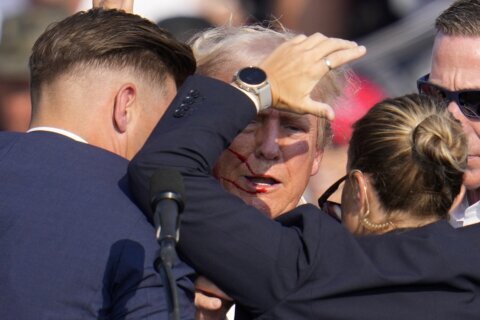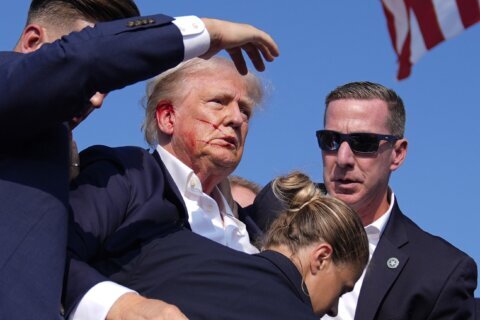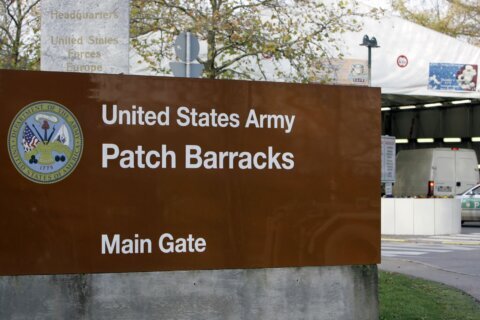Thick black smoke poured out of the Pentagon just after 9:38 a.m.
From the roof of the Voice of America (VOA) building, I saw the intense, dark column surging into the pristine, blue sky, gradually overshadowing what had been a picture-perfect morning.
In New York City, at the North and South towers of the World Trade Center, fires raged as well.
All three buildings had been hit by passenger aircraft.
They were not accidents.
America was under attack, and before that day ended, thousands would die.
Two hundred yards away from VOA, the beacon of U.S. freedom and democracy, the U.S. Capitol sat, distinguished but vulnerable.
It was later determined to be the likely fourth target for 19 hijackers, assembled and trained by al-Qaida. They had been divided into four teams.
By 9:40 a.m., three of their targets had been hit. But a half-hour after United Airlines Flight 93 was overtaken at 9:28 a.m., by the fourth team of hijackers, brave Americans sacrificed their lives and saved the iconic institution.
Alerted by family members about what was happening in New York and at the Pentagon, a group of passengers struggled to regain control of the plane.
At 10:03 a.m., it crashed into a field in Shanksville, Pennsylvania.
‘We reacted as if we were a target’
The panic around D.C. was palpable. People poured out of buildings, not knowing whether theirs would be next.
Confusion reigned, even among law enforcement.
“I remember knowing that there was a plane that had lost contact and was headed towards D.C.,” said Pete Lapp, an FBI special agent at the Washington Field Office (WFO) who has since retired.
“In that moment, we didn’t know what the target was,” Lapp said. Leaders of law enforcement agencies in Washington almost unanimously agreed later that they had the same fear.
“Our leadership thought the WFO could be a target because of all the international terrorism cases that that field office investigated at that time, and we reacted as if we were a target.”
The field office, from their perch just four blocks from the Capitol, could see the smoke at the Pentagon, too.
- ‘I do remember the bodies’: DC-area firefighters reflect on 9/11, 20 years later
- The three men who guided millions of Americans through the day’s horrors
- US to review 9/11 records with eye toward making more public
- Teaching Sept. 11 as history: ‘We could do a better job’
- How events such as Sept. 11 have affected our collective mental health
Agents quickly recognized there was a connection between that fire and those crashes of American Airlines Flight 11 and United Airlines Flight 175 into the World Trade Center towers.
At that moment, Special Agent Tom O’Connor, also from WFO, raced to the basement of their building and decided to do “something that we teach team members not to do.”
He and fellow agent Scott Stanley “self-deployed,” O’Connor said. “We got into my bureau vehicle and headed to the Pentagon.”
They were not alone — hundreds of emergency responders, instinctively and without coordination, followed suit around the region.
All across the city, black SUVs and police vehicles with blue lights raced around, seemingly haphazardly, but all with a purpose — to protect the presidential line of succession, and prevent further attacks.
Key members of the U.S. government were rushed to secret bunkers and hideaways, but the catastrophic surprise of that day triggered the question that few people in America could escape: Would there be a follow-on attack?
One safe place in America
For the next eight hours that day, there would only be one plane in the sky.
The plane was Air Force One, and the reason was that the sky was the only safe place in America.
When President George W. Bush landed that night at Andrews AFB, he spoke to the nation and set in motion events leading to perhaps the most ambitious national security overhaul in U.S. history.
“The search is underway for those who are behind these evil acts,” Bush said. “I’ve directed the full resources of our intelligence and law enforcement communities to find those responsible and to bring them to justice. We will make no distinction between the terrorists who committed these acts and those who harbor them.”
Less than a month later, the Department of Homeland Security was born.
DHS didn’t formally begin its work until 2002. When it did, new security agencies were created, old ones were modernized and some agencies merged. A new sense of purpose and unanimity of spirit emerged.
A key part of its mission was to prevent a repeat of what happened on 9/11.
So far, it’s been successful.
20 years later, ‘9/11 hasn’t stopped’
From where the U.S. sits today, that 20-year effort has resulted in the capture or killing of thousands of terror leaders and followers, including al-Qaida founder Osama bin Laden.
al-Qaida is a mere shadow of its former self, and repeating anything remotely close to the 9/11 attacks would require the unlikely breaching of several layers of security redundancies.
Yet because of the recent fall of Afghanistan, where the 9/11 attacks were planned, worries about terrorism have been reborn among many people.
But those worries never really went away. Tragically, according to O’Connor, “9/11 hasn’t stopped.”
He’s not a making a psychological observation; it’s the medical reality.
“The sad truth of it is, that smoke that you spoke about was full of toxins. And from all of the sites, whether it’s New York City, Shanksville or the Pentagon, we continue to lose people,” O’Connor said.
Thousands of first responders who answered the call that day have died from a variety of health-related conditions connected to the sites where the attacks occurred.
The FBI alone has lost 15 agents and two support staff “from cancers caused by the toxins that we were all breathing in down there,” O’Connor said.
Analysis
Twenty years after the attacks, security in America has changed radically. So has terrorism.
But ironically, after the U.S. and its allies erased the ability of an international terror group to attack the country using sophisticated instruments like airplanes, and took away the global spaces they used to plan them, they may rise again.
The Taliban’s return to power in Afghanistan seems to put everything back at Square One.








